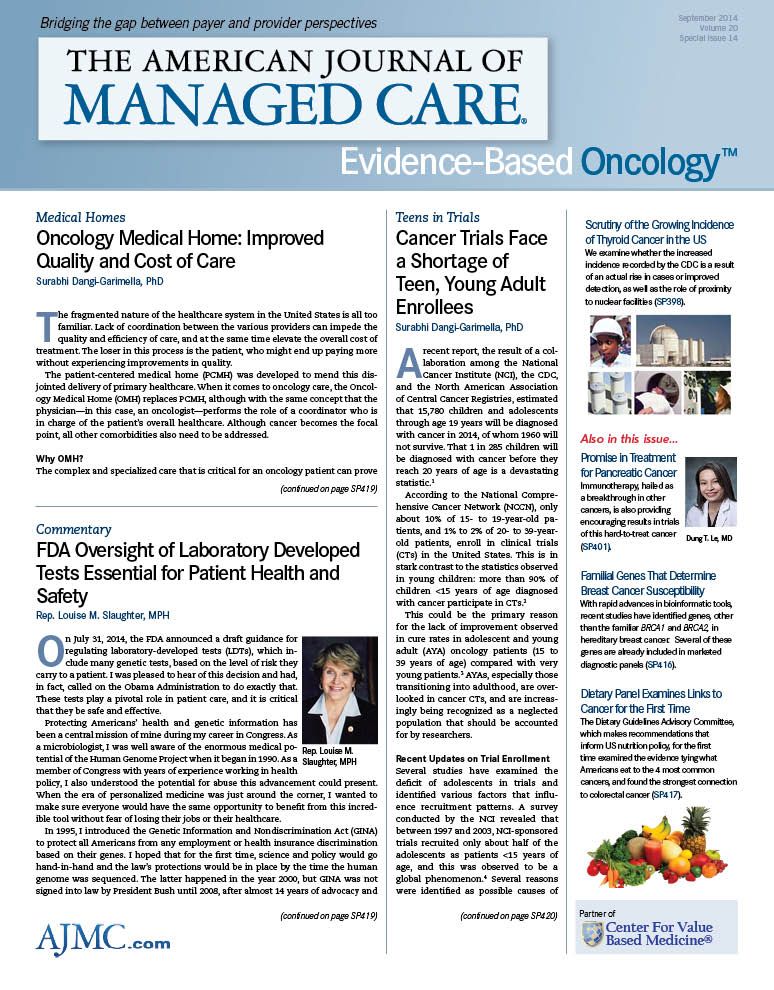- Center on Health Equity & Access
- Clinical
- Health Care Cost
- Health Care Delivery
- Insurance
- Policy
- Technology
- Value-Based Care
Oncology Medical Home: Improved Quality and Cost of Care
The fragmented nature of the healthcare system in the United States is all too familiar. Lack of coordination between the various providers can impede the quality and efficiency of care, and at the same time elevate the overall cost of treatment. The loser in this process is the patient, who might end up paying more without experiencing improvements in quality.
The patient-centered medical home (PCMH) was developed to mend this disjointed delivery of primary healthcare. When it comes to oncology care, the Oncology Medical Home (OMH) replaces PCMH, although with the same concept that the physician—in this case, an oncologist—performs the role of a coordinator who is in charge of the patient’s overall healthcare. Although cancer becomes the focal point, all other comorbidities also need to be addressed.
Why OMH?
The complex and specialized care that is critical for an oncology patient can prove overwhelming for a primary care physician, especially with respect to symptom management (pain, nausea/vomiting, neuropathy, blood count, etc).1 With the oncologist’s clinic filling in as the medical home, the treatment and care process can be optimized to improve quality and efficiency, while minimizing adverse effects. Chemotherapy, in some patients, can lead to severe side effects that are quite difficult to manage and might require additional hospitalization, which can affect treatment outcomes and increase expenditure.1
The following are key traits foreseen for an OMH:
• Coordinated, patient-centered care
• Evidence-based treatment plans with the aim of quality outcomes
• Accessible, efficient, and affordable care
• Care that is continuously improved by measuring against quality standards.1
COA’s OMH Initiative
Community Oncology Alliance wants to model OMH with care coordination, quality, and cost as their mantra. OMH could function on different reimbursement models that would place the patient front and center. COA’s emphasis is on creating an accountable care model balanced with appropriate reimbursement, to ensure patient access to quality care that is also cost efficient.
With this objective, COA’s OMH brings together oncologists, payers, insurance administrators, cancer care advocates, patient advocates, nursing representatives, and pharmacists to steer the initiative toward its goals.2 To convert a clinical practice into a medical home, COA has laid down certain standards:
• Defining core quality and value measures for performance, including patient satisfaction surveys
• Developing a benchmark capability so providers can compare performance with peers
• Develop tools and services that would help a clinic transition to an OMH
• Establish a platform of information exchange for practices to improve outcomes
• Develop different payment models with private payers as well as with Medicare to make OMH a viable oncology model.1
A very important aspect of OMH is gaining accreditation. In collaboration with the Commission on Cancer (CoC), COA has developed an accreditation program—with input from cancer care stakeholders—in the following domains:
• Patient engagement
• Expanded access
• Evidence-based care
• Comprehensive team-based care
• Continuous quality improvement.3
Additionally, several payment-reform initiatives have been undertaken, under the guidance of both oncologists and practice administrators, to explore fee-for-service, shared savings, and bundled or episodic payment models. These initiatives involve COA’s collaboration with the American Society of Clinical Oncology, Medicare, PriorityHealth, Aetna, and UnitedHealthcare, among others. COA will also be hosting a Payer Exchange Summit in Washington, DC, in October to exchange information on payment reform in oncology.4
EBO
OMH promises a radical change in oncology care that is—most importantly—patient-centric. As these models are implemented, and their performance analyzed across practices, we could expect a change for the better in cancer care. References
1. Oncology Medical Home initiative. Oncology Medical Home website. http://www.medicalhomeoncology.org/UserFiles/COA_Oncology_Medical_Home_Initiative_9-21-12.pdf. Accessed September 2, 2014.
2. Oncology Medical Home steering committee. Oncology Medical Home website. http://www.medicalhomeoncology.org/coa/oncology-medical-home-steering committee.htm. Accessed September 3, 2014.
3. Commission on Cancer accreditation. Oncology Medical Home website. http://www.medicalhomeoncology.org/coa/commission-on-canceraccreditation.htm. Accessed September 3, 2014.
4. Bring a payer to attend the Payer Exchange Summit on oncology payment reform. Community Oncology Alliance website. http://www.communityoncology.org/site/blog/ detail/2014/07/31/bring-a-payer-to-attend-thepayer-exchange-summit-on-oncology-paymentreform.html. Published July 31, 2014. Accessed September 4, 2014.

Trends in Hospital Pricing for Vulnerable Emergency Department Users, 2021-2023
December 4th 2025Self-pay emergency department prices rose significantly from 2021 to 2023, especially at for-profit and system-affiliated hospitals, highlighting growing affordability challenges for uninsured and underinsured patients.
Read More
Exploring Racial, Ethnic Disparities in Cancer Care Prior Authorization Decisions
October 24th 2024On this episode of Managed Care Cast, we're talking with the author of a study published in the October 2024 issue of The American Journal of Managed Care® that explored prior authorization decisions in cancer care by race and ethnicity for commercially insured patients.
Listen
Integrated Care for Chronic Conditions: A Randomized Care Management Trial
December 3rd 2025The authors sought to understand the differential impact of payer-led community-based care management approaches on stakeholder-oriented outcomes for publicly insured adults with multiple chronic conditions.
Read More

